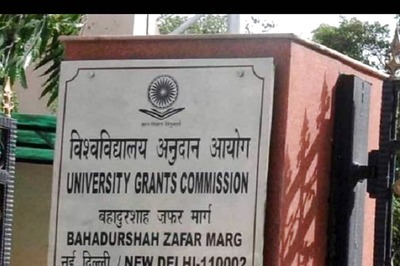
views
New Delhi: The National Crisis Management Committee in an emergency meeting convened by the Cabinet Secretary on Sunday decided to send an expert panel to the Gandhi Sagar dam after the Central Water Commission (CWC) declared its overtopping a “great crisis,” sources told News18.
“The Madhya Pradesh and Rajasthan governments had already sought the Centre’s intervention due to the heavy rains and flooding. The committee has also dispatched an expert panel to Mandsaur on Monday to prepare a report on the crisis that has raised alarms of overtopping along the Chambal and Yamuna rivers,” said an official privy to the developments. “The expert panel will conduct a post-flood analysis of the dam’s behaviour and review its performance on the release of excess water since Saturday,” he added.
Located in Mandsaur district of Madhya Pradesh, the Gandhi Sagar dam is one of the four major dam’s built on the Chambal river. It was completed in 1960 as part of the Chambal River Valley Development projects in the First Five Year Plan of 1951. The dam has a storage capacity of 7.32 billion cubic metres from a catchment area of 22,584 sqkm and can generate power to the tune of 564 Gigawatt hours (GWh).
The CWC declared a crisis at India’s third largest reservoir on Saturday when heavy rains in Madhya Pradesh caused an inflow of 16 lakh cubic foot per second (cusec) and outflow of 5 lakh cusec of water. This led to overtopping in other smaller dams in Rajasthan and Madhya Pradesh, the effects of which were being in Uttar Pradesh and Bihar as well. “The effect of around 45,000 cumec overflow from Gandhi Sagar dam may be seen all along the Ganga, from Allahabad to Patna,” the CWC said.
Himanshu Thakkar of the South Asia Network on Dams, Rivers and People (SANDRP) blamed faulty dam management behind the crisis. “The Gandhi Sagar dam was filled to full capacity few weeks ago. Why was the dam filled up with almost a month of monsoon to go? This violated many of the dam management rules. Sudden heavy rains only made things worse,” he told News18.
Sixty years since it was built, climate change has pushed the dam to go beyond its designed spillway capacity of 21,238 cubic metre per second (cumec). Heavy rains caused the dam to cross both its Full Reservoir Level (FRL) of 399.9m and Maximum Allowed Water Level (MAWL) of 401m.
In 1990, the CWC had declared the dam as unsafe after it was found the spillway capacity of the dam is much lower than the floodwaters it could receive. The World Bank too had declared it unsafe. However, Thakkar said it is difficult to know the actual condition of dam today.
According to Pramod Narayan, programme director at the CWC’s Dam Rehabilitation and Improvement Project, dams across the country are reviewed according to rules of compliance safety analysis. “A pre and post-safety inspection of all dams on their strength happens every year. However, in terms of a comprehensive evaluation, not many dams have been reviewed. Until the Dam Safety Bill was passed in 2019, there was no Central protocol and policy on dams,” he said.
In August, Jal Shakti Minister Gajendra Singh Shekhawat was instrumental in passing the Dam Safety Bill, 2019, in the Lok Sabha. The new bill, which is due in the Rajya Sabha, proposes an emergency action plan for 180 dams in the country and states the guidelines for their surveillance, inspection, operation and maintenance. It is a step forward for 5,745 reservoirs in the country of which 293 are more than 100 years old. The age of 25 per cent of dams is between 50 to 100 years and 80 per cent are over 25 years old.
“Our age-old multipurpose dams have a tendency to operate more as hydropower projects and less as irrigation projects because that’s what earns them revenue,” said Manju Menon, senior fellow at the Centre for Policy Research. According to her, the mismanagement of “multi-purpose dams” – away from its original purpose – contribute a lot to flooding during heavy rains.
“When there is a sudden intense rain happening over a short period of time because of climate change, these dams are unable to manage the large water stock in the reservoir. They store water because it is money but release it when it overtops,” she said.
The flooding in Kota, Rajasthan, has the exact trajectory. The city of Kota faced an unprecedented situation when a record 6.93 lakh cusecs of water was discharged from the Kota barrage – 104 km downstream of the dam after heavy downpour. Kota District Collector Muktanand Agarwal told reporters that more water is likely to be discharged as the Gandhi Sagar dam is still overflowing way above its 1308 feet capacity.
Large areas in several districts of Rajasthan flooded after incessant rains and the release from Kota barrage forced thousands to evacuate. Rescue operations were carried out by the National Disaster Response Force (NDRF) over the weekend in parts of Kota and Chittorgarh district. Mandsaur district, where the Gandhi Sagar dam is located, faced a worse situation due to the heavy rains. Close to 46,000 people from Mandsaur and Neemuch districts were evacuated and moved to safer places on Sunday.
Besides the disastrous effect on human lives, the flooding will also impact the flora and fauna, Prasoon Singh, Associate Fellow at TERI, who works on flood modelling, told News18. “The sedimentation occurring due to floods will destroy crop lands. Core sand particles from the river get deposited on farm lands making them infertile. Flooding also causes river bank erosion,” he said.
The TERI researcher said “reservoir operations” need correction to avoid further loss of livelihood and biodiversity in the middle of climate change. “India does not experience heavy rainfall in September. The downpour in MP and Rajasthan is an extreme and unprecedented event. To battle climate change, we must be equipped with warning systems for dams. If early warnings are issued at least 72 hours before, dams can gradually release the water in an effective manner without affecting the downstream,” Singh said.




















Comments
0 comment